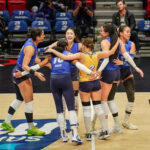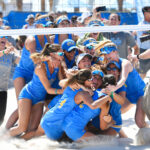Chapter 4: The Great Rift Valley
This morning we left Nairobi to embark on a journey three hours northwest to a small town called Narok. As much fun as I have had in Nairobi these last few days, I could not wait for what this day awaited me.
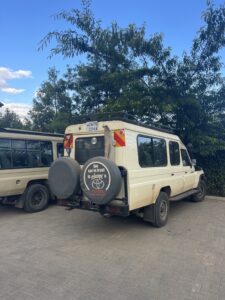
I proceeded to roll my bags up to the back of our new cars for the next three days and saw two Toyota Landcruisers, eight seaters specifically designed and outfitted for safaris. By that alone I knew we were in for a fun day!
The Kenyan National Team and the World Concern staff all piled into the Landcruisers and headed North out of Nairobi! As city life began to show in the rear-view mirror, I began seeing a whole new world before me. Sila, our amazing media guy turned personal tour guide for the day, told me we are on the main road out of Nairobi and further out of Kenya reaching Uganda, Ethiopia, and Somalia. So many goods are being transported daily up and down this main road.
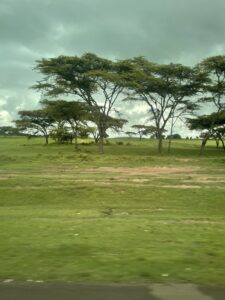
As I sit in this Landcruiser with the window slid back, I cannot help but think I’m a kid going to Disney’s Animal Kingdom for the first time. I’m in a whole new world. My curiosity level went up ten notches and I’m seeing things I’ve never seen before.
For example, I saw Maze, a type of delicious, cooked corn that is popular in Kenya. It was being roasted right on the side of the street. I learned lots of truckers will grab it as a snack as they continue their long hauls into and out of town. I saw burrows chillin and goats grazin. I can confidently say I have seen more goats today than I have in my whole life. But what I have never seen, live and in Technicolor, is a baboon! Just 15 minutes into our drive Sila says, “Look, baboons!”. I whipped my head towards the window to find not just a couple, it was a troop of baboons. They were carrying their babies like backpacks just meandering along the road…some must have been off work when I saw one spread eagle on top of the road barrier tanning in the Kenyan sun. From there I began to think, “What is a typical day in the life of baboon?” I just may never know.

I was told that to get to Narok we needed to go down and back up one of the most well-known valleys on earth, “The Great Rift Valley,” which stretches all the way from Lebanon in the Middle East all the way south to Mozambique, over 4,300 miles. Before continuing down the winding road, we stopped at the Great Rift Valley overlook point to take pics, use the restroom, and take a small peak at some hand-made African gifts.
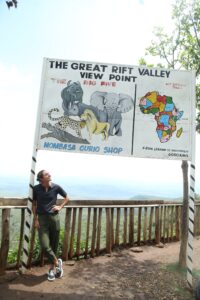
There were so many intricate pieces packed in the small store; they had everything; hand-made coasters, salad tongs, wood art, African masks, and lots of beautiful jewelry such as bracelets, earrings, necklaces, and African headpieces.
As I was meandering and looking, Grace, our security guard held up this African headpiece with beautiful bead work and asked if I liked it, I told her it was very pretty! I thought she was asking to buy it for herself until I began climbing back in the Landcruiser and saw a headpiece sitting in the back seat in front of her. I said, “Grace, you got it! I absolutely love this piece, the colors are amazing!” She smiled at me and said, “Oh it’s for you!” I thought she was joking, not that Grace has joked all that much with me haha, but she proceeded to say, “No really, it’s for you!” I immediately reached over the seats saying thank you! and gave her a big hug!
I have come to realize that from receiving the bracelet in Tokyo to receiving the scarf upon arrival in Kenya, to being given the Kenyan jersey from KCB yesterday, and now being gifted this hand-made African piece of jewelry, it’s safe to say the people of Kenya are givers. They give and look for nothing in return. We climbed back in and headed down to the bottom of the valley. On the way, I was in full-on student mode asking Sila so many questions.
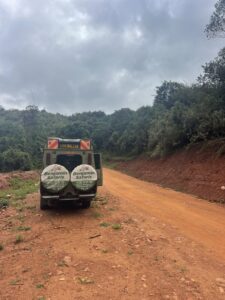
I never asked questions in school. I guess I saved them for here in Kenya! I learned and saw many things as we passed these pastoral communities! It’s hard to boil it down, but here are some things I learned:
-For the Masai people, livestock is their priority.They will follow where their animals graze and drink and will build temporary huts for their stay.
-All men walk with a stick. It is like a rite of passage from being a boy to
becoming a man.
-Cows will cross in the middle of the road on their schedule. It’s their world, we’re just living in it.
-If your car gets stuck, as one did on our drive, people flock to come and help the person get back on the road. Normally where I’m from, if you get stuck on the side of the road, no one is coming, just call AAA.
-Each village community has only one market day each week where everyone comes, near and far, to shop and exchange livestock for money.
As we make our last push into Narok, I couldn’t help but think about how our trip will help make an impact on these people. Our goal is to connect and transform lives through sport. They live such different lives than I do back home. For most of them, sport has never been a thought. They wake up each morning to SURVIVE. I sat there thinking, “What could it look like to introduce the sport of volleyball to these communities? Can sport connect these villages together? Can it reach the end of the road?

As we pulled into our lodging for the next three nights those questions lingered in the back of my mind. I realize that we may not have the answers, but from what I saw from our work in Makuru yesterday, sport really does have power. After seeing the faces of the two girls high school volleyball teams light up with absolute joy after they were given four new volleyballs and a new volleyball net, I knew we were on to something special.
Sports has the power to change the lives of many.
Tomorrow is a new day, and I can only wait to see the joy we can bring to the Morijo and Loita village students tomorrow:)
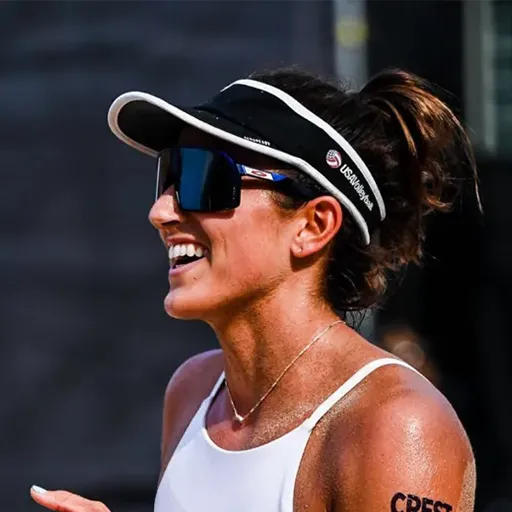
Sarah Sponcil is a prominent figure in the world of professional volleyball, known for her exceptional skills, work ethic and achievements on the court. Born on August 16, 1996, in Phoenix, Arizona, Sponcil began her volleyball journey at the age of three and has been showcasing her immense talent and dedication to the sport ever since.
Garnering three high school state championships in Arizona, and two NCAA national championships at UCLA, Sponcil’s career reached new heights when she represented the United States at the 2020 Olympic Games. At 24 years of age, Sponcil became the second youngest beach volleyball player to ever represent Team USA in the Olympic Games and, together with her partner Kelly Claes, were the youngest beach volleyball team to ever represent Team USA in the Olympic Games.
Following her Olympic success, Sponcil has continued to excel as a professional volleyball athlete, earning numerous accolades and recognition for her prowess as both an indoor and beach volleyball player. Her versatility, athleticism, and relentless determination has solidified her reputation as one of the top players in the sport and make her a force to be reckoned with on any volleyball court.
Off the court, Sponcil is known for her humility, work ethic, and commitment to her faith, family, and desire to inspire the next generation of athletes. She serves as a role model for aspiring volleyball players worldwide, demonstrating that with passion, perseverance and dedication, anything is possible in the world of sports.
Search Posts
Categories
Latest Releases
Beyond Skill: What does leadership mean to you?
Championship Team: Lessons from Faith & Sports
I’ll Be Home For Christmas
Search Posts
Categories
Latest Releases
